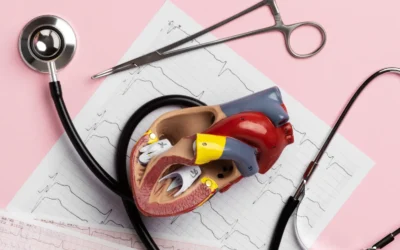Angina is essentially chest pain or discomfort stemming from inadequate blood flow to the heart muscle. The discomfort isn’t always confined to the chest; it can also manifest as pressure in the chest, jaw pain, or arm discomfort.
Angina predominantly occurs when the coronary arteries, responsible for supplying blood to the heart, become narrow due to atherosclerosis (plaque buildup in the arteries) or a spasm of the coronary arteries.
Table of Contents
Understanding the Varieties of Angina
Stable angina presents as pain or tightness that’s typically triggered by consistent high activity levels, such as climbing stairs after an emotional discussion or during stressful periods. It’s usually predictable, occurring when your heart works harder due to factors like cold weather or consuming large meals. Rest, relaxation, and nitroglycerin can alleviate this pain.
Unstable angina, however, brings about chest pain or tightness without a clear trigger or a sudden worsening of stable angina. It may lead to a decreased ability to exercise without experiencing chest pain, more intense pain, or longer-lasting pain. This is a medical emergency, and you should contact your healthcare professional immediately. If you’re experiencing active pain, don’t hesitate to seek help from the emergency room or dial 911.
Variant angina is characterized by chest pain or pressure resulting from the sudden constriction or spasm of the coronary artery, cutting off blood flow to the heart muscle. This condition is also known as Prinzmetal’s angina or vasospastic angina. While the spasm is typically temporary, it can induce a similar type of pain as a heart attack or coronary artery disease. Remarkably, coronary artery spasms can occur in individuals who have never used drugs like cocaine.
Variant angina usually occurs during periods of rest, and it’s slightly more frequent at night but can manifest at any time of day. Typically, it lasts for a few minutes and can be relieved with nitroglycerin.
Identifying Angina Signs and Symptoms
Typical angina symptoms comprise chest pain or pressure, which may radiate to the neck, jaw, or arm. Nevertheless, some individuals may experience angina in the form of shortness of breath, upper abdominal pain, indigestion, lightheadedness, extreme weakness, tiredness, or general discomfort. Women, in particular, might experience additional symptoms alongside chest pain or pressure.
When Should You Reach Out to Your Doctor or Seek Emergency Care?
To effectively manage angina, it’s vital to recognize the unique characteristics of your angina, so you can discern when it’s time to seek assistance. Don’t delay in calling 911 if your angina becomes more severe, frequent, or longer-lasting than usual. In such cases, contact your healthcare professional immediately. Emergency care is also warranted if chest pain occurs while you’re at rest, without physical exertion.
Medical Examinations and Tests
Distinguishing angina from other causes of chest pain can be a complex task. Your healthcare professional will undertake a comprehensive history and physical examination. They’ll inquire about the specifics of your chest pain: its location, accompanying symptoms, timing, duration, and factors that alleviate or exacerbate it.
An electrocardiogram (ECG) may be conducted to assess heart rate and rhythm, as well as to detect any past heart attacks or reduced blood flow to the heart muscle, known as ischemia. It can also guide decisions about the need for a stress test.
When there’s concern that your chest pain may result from coronary artery disease, your healthcare professional may recommend a stress test, either with or without imaging. During a stress test, the objective is to challenge your heart and determine if it receives sufficient blood supply to meet the demands of increased activity.
Other imaging stress tests may use ultrasound to capture images of the heart muscle before and after exercise. Reduced heart muscle movement in these tests may indicate a blockage or constriction in the blood flow to that particular area of the heart.
Additional tests, like the coronary calcium score and coronary computed tomography, can help identify atherosclerosis or narrowing of the coronary arteries. In cases of suspected heart attack, blood work may be necessary, and you might be advised to proceed directly to the emergency department.
Treatment Options
Effectively managing stable angina involves adopting heart-healthy habits, such as maintaining an active lifestyle, quitting smoking, and embracing a healthy diet. Your healthcare professional may also prescribe medications, some of which target risk factors contributing to angina and coronary artery disease, while others aim to alleviate symptoms.
Your healthcare professional will work with you to identify the optimal combination of medications and treatments for your specific condition.
Exploring Medications
A variety of medications are available to address angina symptoms. Beta blockers, for instance, ease the heart’s workload by reducing heart rate and lowering blood pressure. If you’ve experienced a heart attack, these medications can help prevent future occurrences and extend your lifespan.
Nitroglycerin and nitrates enhance blood flow to the heart by dilating blood vessels, allowing blood to reach the heart muscle more easily when coronary arteries are narrowed. They also reduce the heart’s workload in supplying blood to the body.
Calcium channel blockers, akin to beta blockers, reduce the heart’s workload by slowing heart rate and lowering blood pressure. However, not all medications in this category impact heart rate to the same degree, but they’re all useful in managing high blood pressure. They’re typically not prescribed if you have a weakened heart.
Ranolazine operates directly on the heart, promoting relaxation and reducing the heart muscle’s workload. Unlike other angina medications, it accomplishes this without altering blood pressure or heart rate.
Procedures and Surgery
To restore blood flow to areas of the heart muscle that aren’t receiving adequate blood supply, procedures and surgeries might be necessary. The two primary methods for achieving this are angioplasty, often referred to as percutaneous coronary intervention (PCI), with stents or balloon procedures, and coronary artery bypass graft (CABG) surgery, commonly known as open-heart surgery. The choice between these methods hinges on your symptoms, preferences, the number and location of narrowed or blocked arteries, your age, overall health, and other risk factors. Following PCI, antiplatelet medications are usually prescribed.
Cardiac Rehabilitation
Cardiac rehabilitation (rehab) is a medically supervised 12-week program, aimed at providing counseling on exercise, heart-healthy eating, stress management, and smoking cessation. It also educates individuals on taking control of their health.
In some regions, intensive cardiac rehab is available, consisting of nine weeks of four-hour sessions, two times per week. These sessions involve supervised exercise, nutritional counseling, stress relief activities, and group support. This intensive program typically yields even better results than traditional cardiac rehab. It’s worth noting that cardiac rehab can reduce angina, mitigate heart risk factors, and enhance overall quality of life.
Enhanced External Counterpulsation Therapy
Enhanced external counterpulsation (EECP) therapy is an option for individuals with angina that significantly impairs their daily activities and hasn’t responded to standard treatments. During EECP, inflatable cuffs, similar to blood pressure cuffs, are placed on the calves, thighs, and buttocks. These cuffs inflate and deflate in sync with your heartbeat, improving blood flow to the heart. EECP may stimulate the formation of small blood vessels in the heart, creating a natural bypass around blocked or narrowed arteries. This therapy can extend exercise duration and reduce angina.
Prevention Measures
To avert angina caused by atherosclerosis, it’s crucial to target the risk factors associated with coronary artery disease. Medications like aspirin and statins can assist in this endeavor.
Aspirin, often recommended as a daily regimen, facilitates blood flow through blood vessels, particularly beneficial for those with atherosclerosis, as it reduces the risk of subsequent heart attacks or strokes.
Statins, on the other hand, lower levels of low-density lipoprotein (LDL) cholesterol, often referred to as “bad” cholesterol, in the bloodstream. Lowering LDL cholesterol reduces the likelihood of its accumulation in heart or brain blood vessels, lowering the risk of heart attacks or strokes.
It’s important to remember never to commence or cease any medication without first consulting your healthcare team.
Taking Action to Prevent Angina
Preventing angina involves making lifestyle adjustments that reduce the risk of heart disease. These include:
- Controlling blood pressure: Maintain healthy blood pressure through lifestyle changes and medication if necessary.
- Smoking cessation: Quitting smoking is one of the most effective steps you can take to prevent a heart attack.
- Regular exercise: Engage in physical activity like brisk walking, running, or biking for at least 30 minutes on most days of the week. This can help reduce blood pressure, increase good cholesterol levels, and better control blood sugar.
- Healthy diet: A balanced diet rich in fruits, vegetables, whole grains, fish, and lean meats is essential, while sugary beverages, refined grains, and processed or red meats should be avoided.
- Stress management: Chronic high stress levels can contribute to heart disease and angina. Maintaining a well-balanced life is crucial for heart health. If stress worsens your angina symptoms, discuss this with your healthcare professional.
Understanding angina, its various forms, and the steps to manage and prevent it is essential for maintaining heart health and overall well-being. If you have any concerns or experience symptoms related to angina, seek guidance from your healthcare provider promptly.
Frequently Asked Questions
What is the difference between chronic angina and a heart attack?
Chronic angina is chest pain or discomfort caused by reduced blood flow to the heart muscle, often due to narrowed arteries. It’s typically triggered by exertion or stress and subsides with rest or medication. In contrast, a heart attack occurs when there’s a sudden, complete blockage in one of the coronary arteries, leading to damage or death of heart muscle. Heart attack symptoms are more severe and can be life-threatening.
Does having angina mean that I have blockages in the arteries that supply my heart muscle with blood?
Angina is often associated with blockages or narrowing of the coronary arteries. However, not all cases of angina are caused by artery blockages. It’s essential to consult your healthcare provider for a proper diagnosis and evaluation.
What medications are available to treat angina?
Medications for angina include beta-blockers, nitrates, calcium channel blockers, and ranolazine. Your healthcare provider will determine the most suitable medication based on your specific condition.
What changes in my symptoms should alert me to notify my health care provider?
You should contact your healthcare provider if your angina becomes more severe, more frequent, or longer-lasting than usual. Additionally, any chest pain occurring at rest should prompt immediate medical attention.
What risk factors are linked with angina?
Risk factors for angina include high blood pressure, high cholesterol, smoking, diabetes, obesity, a sedentary lifestyle, and family history of heart disease.
Can I continue to exercise if I have angina? How active can I be?
Regular exercise is generally beneficial for individuals with angina. Discuss your exercise plan with your healthcare provider, and they can help you determine a suitable level of activity based on your specific condition.
What lifestyle changes can I make to reduce my symptoms?
Lifestyle changes include quitting smoking, maintaining a heart-healthy diet, managing stress, controlling blood pressure, and engaging in regular physical activity.
Should I have a stress test for angina?
Stress tests are often used to diagnose angina by assessing how your heart responds to physical stress. Your healthcare provider will determine if this test is necessary based on your symptoms and medical history.





0 Comments